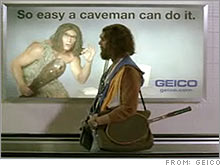
Posted on 05/01/2007 6:30:29 PM PDT by Diana in Wisconsin
(Scientist says modern humans, earlier species found camaraderie, and sometimes a mate, in each other)
Researchers have long debated what happened when the indigenous Neanderthals of Europe met "modern humans" arriving from Africa starting some 40,000 years ago. The result was the disappearance of the Neanderthals, but what happened during the roughly 10,000 years that the two human species shared a land?
A new review of the fossil record from that period has come up with a provocative conclusion: The two groups saw each other as kindred spirits and, when conditions were right, they mated.
How often this happened will never be known, but paleoanthropologist Erik Trinkaus says it probably occurred more often than is generally imagined.
In his latest work, published last week in the journal Proceedings of the National Academy of Sciences, Trinkaus, of Washington University in St. Louis, analyzed prehistoric fossil remains from parts of Europe. He concluded that a significant number have attributes associated with both Neanderthals and the modern humans who replaced them.
"Given the data we now have, it would be highly improbable to argue there is no Neanderthal contribution to the early European population that came out of Africa," Trinkaus said. "I believe there was continuous breeding between the two for some period of time. Both groups would seem to us dirty and smelly but, cleaned up, we would understand both to be human. There's good reason to think that they did as well."
The conclusion, one of the strongest to date in this debate, remains controversial, and it has potentially broad implications. It suggests, for instance, that humans today still should have some Neanderthal genes. It also means that the unanswered question of why the Neanderthals died out is even more puzzling, because under this scenario they were quite capable of living successfully alongside the more modern newcomers.
But Trinkaus says the fossil record is the best information available, and it increasingly points to an "admixture" theory - that Neanderthals who had lived in Europe for about 400,000 years shared the land and, to some extent, their genes with the migrants from the south who began arriving 40,000 years ago.
Theory questioned
As with all theories regarding the Neanderthals, there are problems with the one that Trinkaus and others are advancing. So far, analysis of modern humans' DNA has turned up no identifiable Neanderthal genetic material. Instead, it points to a common East African male ancestor from about 100,000 years ago and a common East African female from 170,000 years ago. Because the sampling remains limited, evolutionary geneticists generally do not say their findings settle the matter, though an ongoing mapping of the Neanderthal genome by European researchers may change the equation.
Chris Stringer, a paleontology researcher at the Natural History Museum in London, said the genetic evidence has kept him "on the fence" regarding Trinkaus' theory of more widespread interbreeding. He said Neanderthals and modern humans from Africa would be considered distinct "homo" species, making interbreeding less likely but not impossible. Under stressed conditions, he said, zebras and horses will mate, as will lions and tigers, so related humans might have done the same.
But one genetic trait of modern Europeans makes him doubt there was any major Neanderthal input - the fact that most humans today are genetically ill-adapted to cold weather. Only some native Indian populations, as well as people in the north of Eurasia and aborigines in Australia, who experience deep cold at night, have good genetic defenses to cold.
Because Neanderthals lived in Europe for hundreds of thousands of years, through ice ages and frigid conditions, they would have become genetically suited to such conditions, Stringer said. The fact that Europeans are not, he said, suggests that any Neanderthal contribution to their makeup is limited.

“I believe ... there’s good reason to think ..” yeah right.
Maybe I’m a neanderthal after all. I’ve been told as much!
Prior to my retirement it was my pleasure to ride the Washington Metro (subway) every weekday and observe the occupants thereon, and I can tell you that that the Neanderthal genes are alive and well in our midst.
ROFLMAO! :)
I love that site. Too clever by half. Wish I had that Caveman’s kitchen. D@mn! :)

LOL!
I have been referred to as a “knuckle-dragger” by the ‘educated elite’ upon occasion.
Perhaps they were unknowingly correct!
YEC INTREP
ggg ping
The Neandertal EnigmaFrayer's own reading of the record reveals a number of overlooked traits that clearly and specifically link the Neandertals to the Cro-Magnons. One such trait is the shape of the opening of the nerve canal in the lower jaw, a spot where dentists often give a pain-blocking injection. In many Neandertal, the upper portion of the opening is covered by a broad bony ridge, a curious feature also carried by a significant number of Cro-Magnons. But none of the alleged 'ancestors of us all' fossils from Africa have it, and it is extremely rare in modern people outside Europe." [pp 126-127]
by James Shreeve
Please FREEPMAIL me if you want on or off the
"Gods, Graves, Glyphs" PING list or GGG weekly digest
-- Archaeology/Anthropology/Ancient Cultures/Artifacts/Antiquities, etc.
Gods, Graves, Glyphs (alpha order)
Clan of the Cave Bear ;D

Disclaimer: Opinions posted on Free Republic are those of the individual posters and do not necessarily represent the opinion of Free Republic or its management. All materials posted herein are protected by copyright law and the exemption for fair use of copyrighted works.